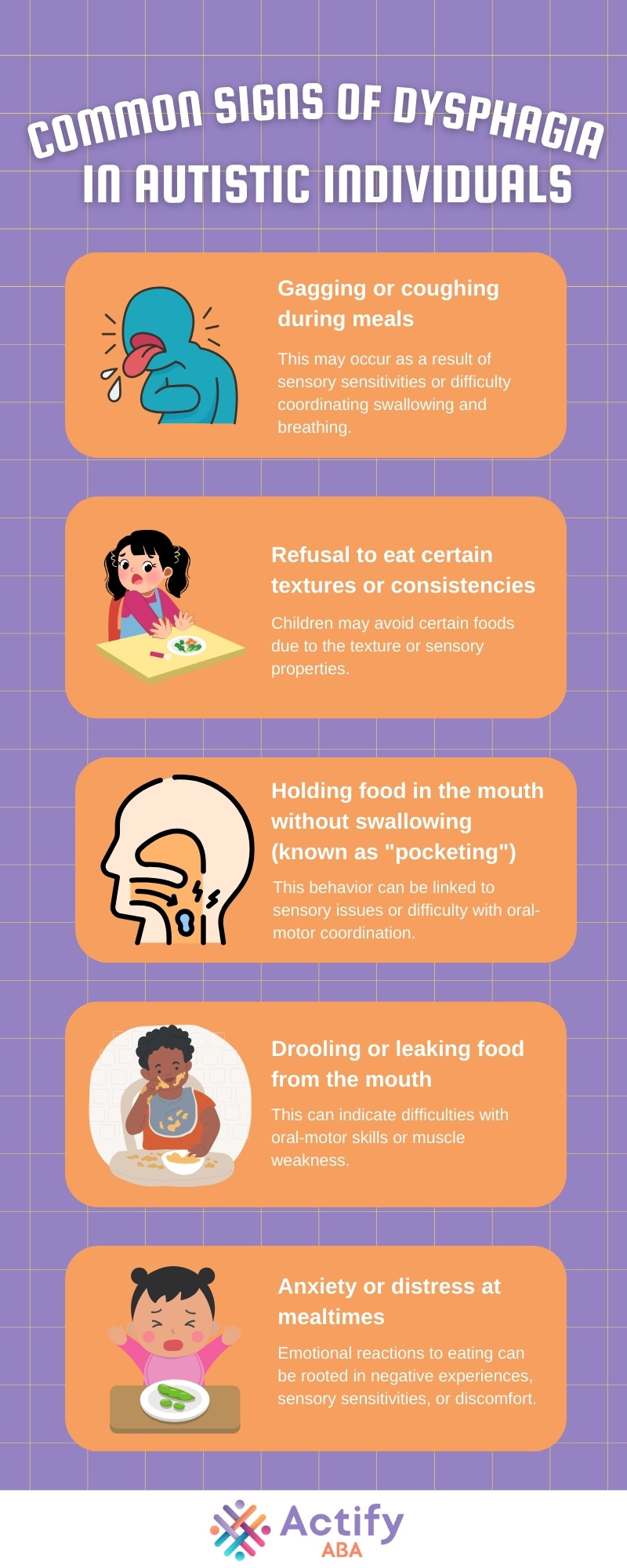
Key Points:
- Habitual dysphagia in autism refers to persistent swallowing difficulties that often stem from behavioral or sensory processing issues.
- The causes of dysphagia in autistic individuals can be multifactorial, involving both physical and behavioral components.
- Early intervention, feeding therapy, and ABA-based strategies can help improve swallowing safety and reduce feeding-related stress.
Research indicates that about 62% of children with ASD experience feeding difficulties. However, one of the more serious and often misunderstood issues is habitual dysphagia in autism.
This refers to chronic difficulties in swallowing that may not always have a medical root but are reinforced over time by behavior, fear, or sensory discomfort. Parents and caregivers often struggle to find clear answers, especially when traditional medical tests come back normal.
In this article, we’ll talk about dysphagia, how it manifests in children with autism, and offer some helpful tips that can help you support your child at home.
What Is Habitual Dysphagia in Autism?
Habitual dysphagia in autism is a persistent swallowing difficulty caused or maintained by behavioral or sensory patterns rather than underlying anatomical problems. It may involve learned avoidance behaviors or overreactions to specific textures, tastes, or swallowing sensations.
Unlike structural dysphagia, which is rooted in physical impairments of the throat or esophagus, habitual dysphagia often stems from psychological or neurological responses. It can be deeply distressing, leading to food refusal, nutritional deficits, and even aspiration risk in some cases.
How Does Dysphagia Present in Autistic Individuals?
Dysphagia in autistic children doesn’t always look the same as in neurotypical individuals. Because many children on the spectrum have communication differences or sensory sensitivities, the signs can sometimes be subtle or mistaken for behavioral noncompliance.
Parents may notice common signs including:

These behaviors can become entrenched over time, especially if eating has historically been a stressful or painful experience.
What Causes Habitual Dysphagia in Autism?
The roots of habitual dysphagia are complex. For children with autism, this behavior can be driven by multiple factors that intertwine and reinforce one another over time.
Sensory sensitivities, anxiety around mealtime routines, and past negative experiences with food can all contribute to the development of habitual dysphagia, making it more difficult to overcome without targeted intervention.
Here are some common causes:
1. Sensory Processing Differences
Many autistic children are hypersensitive to certain textures, temperatures, or consistencies of food. If a food feels “wrong” in the mouth, a child may avoid swallowing altogether.
2. Learned Behaviors
Negative experiences with choking or vomiting may cause a child to associate swallowing with danger. Over time, avoidance becomes habitual—even if the initial cause is no longer present.
3. Motor Planning Challenges
Some children may struggle with oral-motor coordination. Even if their muscles work properly, the brain may not effectively plan the steps involved in chewing and swallowing.
4. Anxiety and Hypervigilance
High levels of anxiety, especially surrounding meals, can lead to muscle tension or disrupted swallowing patterns. Fear of choking or gagging can increase avoidance behaviors.
5. Co-occurring Medical Conditions
Conditions like acid reflux, esophageal motility disorders, or enlarged tonsils can trigger early swallowing issues, which may then develop into habitual dysphagia even after the medical issue is resolved.
What Are the Risks of Untreated Dysphagia?
While habitual dysphagia may not stem from structural damage, it can still lead to serious complications if not addressed. When swallowing is consistently avoided, long-term consequences can arise both physically and behaviorally. Potential risks include:
- Malnutrition from limited food intake
- Dehydration, especially if fluids are also avoided
- Poor weight gain or weight loss
- Aspiration pneumonia if food or liquid enters the lungs
- Increased mealtime anxiety and family stress
- Negative associations with feeding that are hard to reverse
Recognizing and treating habitual dysphagia early can help prevent escalation and support healthier mealtime patterns.
How Can Parents Identify Habitual vs. Medical Dysphagia?
Distinguishing between medical and behavioral dysphagia is critical, but not always straightforward. A full medical evaluation should always be the first step. Once physical causes are ruled out, habitual patterns can then be addressed with the appropriate interventions.
Here’s a general comparison of the two types:
Medical Dysphagia
Medical dysphagia is caused by physical issues such as muscle weakness, neurological conditions, or anatomical abnormalities that interfere with the swallowing process. It is often confirmed through clinical tests like a swallow study or endoscopy, which help identify structural or physiological problems.
Treatment may involve surgical or medical intervention, depending on the root cause. Symptoms of medical dysphagia typically persist across different contexts and may worsen over time without medical support.
Habitual Dysphagia
Habitual dysphagia, on the other hand, is rooted in learned behaviors, sensory sensitivities, or anxiety that disrupt a child’s ability or willingness to swallow. This form of dysphagia is usually considered after medical causes have been ruled out through a comprehensive evaluation.
It is typically treated using behavioral and therapeutic strategies, often with support from specialists like speech-language pathologists or ABA therapists. Symptoms tend to show up in specific settings, such as at home or with certain foods, and may be inconsistent, which can make it harder to identify without professional insight.
If your child has a clean medical workup but continues to struggle with swallowing or mealtime participation, habitual dysphagia is worth exploring as a working diagnosis.
What Treatment Options Are Available?
Managing habitual dysphagia in autism requires a team-based approach that takes into account sensory, behavioral, and developmental factors. Each child’s plan should be individualized, but there are common intervention strategies that have shown success.
Before listing treatment strategies, it’s important to note that consistency and patience are key. Improvements can be slow, especially when avoidance behaviors are deeply ingrained.
Common intervention strategies include:
1. Feeding Therapy
Feeding therapy is typically led by occupational or speech-language therapists who have experience in treating pediatric dysphagia.
The sessions focus on improving oral-motor skills, teaching safe swallowing techniques, and helping children gradually become comfortable with previously feared textures or foods.
2. Applied Behavior Analysis (ABA) Techniques
ABA techniques are often integrated into feeding support plans, using positive reinforcement to encourage a child’s participation in meals.
This approach breaks the feeding process into small, manageable steps while also identifying and addressing behaviors like feeding refusal or avoidance that may be reinforced by escape from mealtime demands.
3. Desensitization Programs
Desensitization programs involve gradually exposing children to triggering foods or textures in a calm, non-threatening environment.
These programs often begin with simply touching or smelling the food, with no pressure to swallow, helping to build tolerance and reduce sensory-related anxiety.
4. Visual Schedules and Social Stories
Visual schedules and social stories can help children understand the structure of mealtimes and what to expect. By adding predictability, these tools reduce anxiety and make the process of eating feel more manageable and less overwhelming.
5. Parent Coaching and Training
Parent coaching equips caregivers with the knowledge and tools needed to support feeding goals outside of therapy sessions. This guidance empowers families to reinforce progress at home and maintain consistency across different settings.
6. Adaptive Utensils and Seating
Using adaptive utensils and proper seating arrangements can significantly reduce physical barriers to safe and effective eating. These tools are especially beneficial for children with low muscle tone or postural instability, providing the stability needed to participate in meals more comfortably.
Each of these approaches can be adapted based on the child’s age, communication level, and specific triggers.
When Should Parents Seek Help?
If your child consistently shows signs of swallowing avoidance, discomfort during meals, or poor nutritional intake, it’s time to seek support. While occasional pickiness is common, habitual dysphagia reflects a pattern that doesn’t improve without intervention.
Consider reaching out if:
- Meals regularly take over an hour due to delays or refusals.
- Your child avoids entire food groups or textures.
- Gagging, coughing, or vomiting occurs more than once a week.
- You feel stressed, anxious, or overwhelmed around mealtimes.
- Growth charts show a plateau or drop in weight.
Early support can prevent further complications and improve your child’s overall well-being.
How Can ABA Therapy Support Feeding Challenges?
Applied Behavior Analysis (ABA) is widely used to address behavioral concerns in autism, but it can also be tailored to support feeding disorders. ABA activities are especially effective for habitual dysphagia when the behavior is rooted in avoidance or learned patterns.
ABA-based feeding support may include:
1. Reinforcement Systems
Reinforcement systems are used to encourage safe swallowing and the willingness to try new foods. Positive reinforcement, such as verbal praise or a small reward, helps increase a child’s motivation to participate in mealtime routines.
2. Data-Driven Analysis
Data-driven analysis is used to identify specific triggers that lead to feeding refusal and to track progress over time. This allows therapists to make informed adjustments to the treatment plan based on the child’s actual behavior patterns.
3. Individualized Behavior Plans
Behavior plans are designed to reduce escape behaviors or tantrums that occur during meals. These plans include clear strategies for preventing problem behaviors and teaching more appropriate responses to mealtime stress.
4. Gradual Exposure Protocols
Gradual exposure protocols are customized to match the child’s unique sensory sensitivities and comfort levels. These step-by-step approaches help children become more tolerant of new foods without overwhelming them.
5. Integrated Collaboration
Collaboration with speech or occupational therapists ensures that feeding interventions address both behavioral and physical challenges. This multidisciplinary approach enhances outcomes by supporting the child’s needs from multiple angles.
ABA isn’t about forcing children to eat. It’s about creating a safe, structured environment where positive eating behaviors can emerge—something that becomes even clearer when we understand how different developmental needs affect behavior, as explained in Autism and Developmental Delay: Understanding the Differences.
Support Your Child’s Mealtime Success with ABA Therapy in Maryland
At Actify, we know that feeding issues go far beyond picky eating. For families navigating habitual dysphagia in autism, our ABA therapy services in Maryland offer structured, compassionate support designed to help children build healthier eating behaviors, step by step.
Whether your child avoids swallowing due to anxiety, sensory triggers, or previous negative experiences, our therapists use evidence-based strategies to make mealtimes more manageable for everyone involved.
By addressing the behavior behind the symptom, we help unlock progress that leads to lasting improvement. Ready to learn more? Contact us today to find out how ABA therapy can support your child’s growth!
